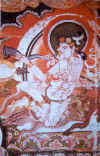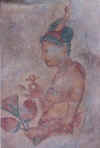|
|
||||
|
JULY 2001- Contents Indo-Pak Focus Agra Summit- the happier moments Begum Sehba Musharraf's time in India Cuisine
Diplomacy Indo-Pak Reconciliation School People Fashion &
Lifestyle Fashion
Graduates - India Heritage Art
Health Music 'United for Gujarat' - the first South Asian concert' Travel & Adventure Books
|
|
|
||
|
the-south-asian.com July 2001 |
||||
|
page 2 of 2
Benoy Behl - Documenting the Art of India by Mukesh Khosla (cntd)
Buddhist Art " The Ajanta caves are the
fountainhead of Asian paintings and also the most beautiful embodiment of
Buddhist art. They were made in accordance with the guidelines given in
Vishnudharmottara's Chitrasutra, the earliest known treatise on
art," says Behl. Over the years, Indian art absorbed
numerous foreign influences but retained its own identity as well. After
Ajanta, some of the most significant works of art came during the medieval
times from Bijapur and Kangra. Bijapur was strongly influenced by the
Bhakti movement of the Deccan, which helped elevate the region's art to
lofty heights. Art in the Kangra hills too was unique as it was strongly
influenced by Persia. Here too it was devotional and dedicated mainly to
Radha and Krishna. These documentaries will also trace the
development of the Mughal School of paintings under the patronage of Emperor
Akbar who not just revived art in Northern India but elevated the status of
artist in society. He showered them with awards and rewards which is
why his era was called the golden age of medieval art. The series will not not just document art
and artists but also the historical and philosophical influences that
created the fountainheads of Indian art in different ages. Behl and his team members recently
embarked on the mission of completing the 26 documentary series that would
take them to over 100 cities around the world traversing some 58,000 miles. " Most western art historians
thought that Ajanta Caves were a flash in the pan. And that Indian art never
really progressed after that. They said that it was only when the Mughals
arrived that things started looking up. And the art scene became really
vibrant during the British Raj," says Behl. However, Behl's photographs of the 10th. century Chola paintings in Tanjore (Thanjuvar), were an eye-opener for the western critics. Suddenly historians started seeing the three-century continuity between Ajanta and Chola art. Behl who has lectured on Indian art at the Harvard University and the Smithsonian Institute in Washington among other centres around the world, says that he is working on a tight time-frame and would complete the project on schedule.
Two years ago Behl was also the moving force behind the Indian government's efforts to get the Mahabodhi temple complex listed in the UNESCO World Heritage sites. The efforts have paid off and the temple is soon being declared a world heritage site. Mahabodhi Temple is a monument where people from all over the world throng to offer prayers and seek blessings of the Enlightened One. The Bodh tree beneath which Buddha sat in meditation is of the highest significance to Buddhists. In fact, over the past decade Behl and Nigam have been traversing remote areas in Ladakh on foot and on horseback in search of ancient Buddhist monasteries abandoned centuries ago. Their three visits in 1996, 1997 and 1998 yielded astounding results. The two rediscovered monasteries, some dating back to the tenth and eleventh centuries, which were lying in ruins in the central Leh district as well as those in the remote mountainous regions of Zanskar, Kargil and Nubra. Painting in the Alchi Monastery in Ladakh…Re-discovered by Behl & his teamThe two conservationists photo-documented 51 of these monasteries and discussed with monks, scholars and Rinpoches (heads of the monastic sects) the urgent measures required for their preservation. According to Behl " These Gompas (monasteries) and Lhakhangs (temples) need urgent preservation. Some of them are approachable by road; others by dirt tracks and the time taken can vary from a few hours of walking to a few days on horseback. But they are all approachable."Their efforts resulted in setting up of
the Cultural Documentation and Conservation Foundation to preserve, research
and photo-document monasteries of Ladakh. Says noted historian, Prof.Lokesh Chandra, " for the history of Indian paintings many of these monasteries are as important as Ajanta. Unfortunately several important heritage sites with their art have already been lost to the ravages of time. Unless the earliest action is taken to save these monasteries and their paintings, they will be lost forever." Establishing continuity in art.. Sigruja mural, Sri LankaBehl has taken Prof. Chandra's concern very seriously. His journey of discovery is all encompassing. It is an effort to establish a link between Buddhist and Hindu art. Starting from the Ajanta Caves, Behl and his team will travel to Hampi and then to Sri Lanka, before jetting off to Zurich, Paris, London, Boston, Tokyo, Singapore and Kathmandu - " And the other places where Indian art lies scattered in museums, temples and monasteries," as Behl puts it. ____________
|
||||
| Copyright © 2000 [the-south-asian.com]. Intellectual Property. All rights reserved. | ||||
| Home |



